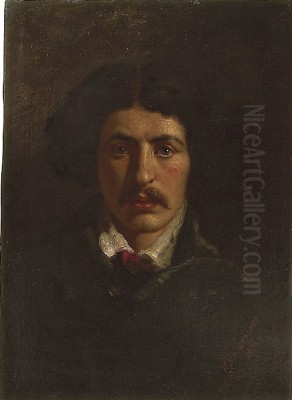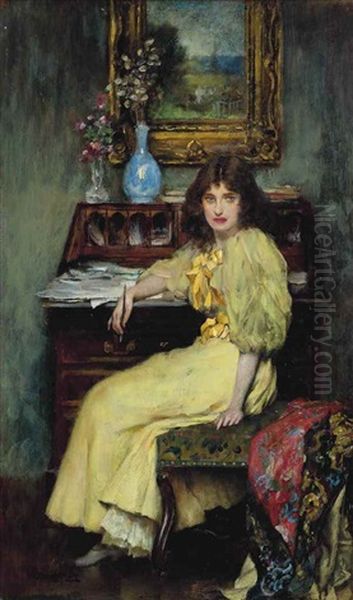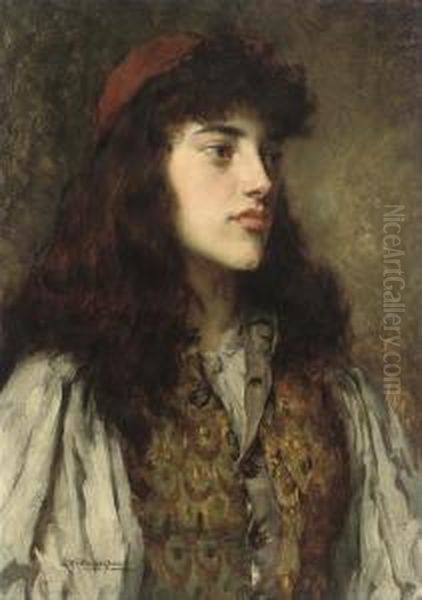
William Arthur Breakspeare stands as a notable figure within the vibrant landscape of late Victorian British art. Active during a period of significant artistic evolution, Breakspeare carved a niche for himself primarily through his evocative portraiture and engaging genre scenes. His life spanned from 1855 to 1914, placing him amidst a generation of artists grappling with the legacy of Pre-Raphaelitism, the rise of realism, and the burgeoning influence of continental European art movements. Though perhaps not as universally recognized today as some of his contemporaries, his work offers valuable insights into the artistic concerns and social nuances of his time, particularly through his connections with the Birmingham School and the Newlyn School art colonies.
Origins and Artistic Emergence
Details surrounding William A. Breakspeare's early life, including his precise birthplace and formal artistic training, remain somewhat elusive based on commonly available records. Born in 1855, he emerged as a practicing artist in the latter decades of the 19th century. The lack of specific information regarding his education does not diminish the evident skill and sensitivity present in his work. His development likely involved rigorous self-study and potentially instruction within regional art institutions or private studios, common paths for aspiring artists during that era before the widespread formalization of art academies.
His career gained traction in the late 1870s and early 1880s, coinciding with a period of great dynamism in British art. He began exhibiting his works, gradually building a reputation for his adept handling of oil paint and his ability to capture character and mood. Early pieces, such as the Bust Portrait of a Breton dated 1879, suggest potential travels or an interest in depicting subjects beyond the immediate English environment, a common practice among artists seeking diverse inspiration and picturesque themes. This particular work hints at an early engagement with realism and character study.
The Birmingham Connection

Breakspeare became significantly associated with the Birmingham School of artists, also known sometimes as the Birmingham Group or Art Circle. This was a dynamic collective of painters based in the industrial heartland of England. Birmingham, a city transformed by the Industrial Revolution, fostered a unique artistic environment. The Birmingham School artists often shared a commitment to strong technical skills, detailed observation, and frequently depicted scenes infused with narrative or emotional weight.
He was considered an important member of this circle, working alongside prominent figures such as Walter Langley, who was instrumental in the group's formation around 1880. Other key members included William Wainwright and Edwin Harris. These artists often focused on realism, depicting both the burgeoning middle-class life of the city and sometimes venturing into more rural or historical subjects. Breakspeare's involvement placed him within a supportive network that encouraged high standards of craftsmanship.
The Royal Birmingham Society of Artists (RBSA) served as a crucial venue for Breakspeare and his peers. Exhibiting regularly at the RBSA allowed him to showcase his work to a regional audience and establish his credentials within the local art hierarchy. The society played a vital role in promoting the work of Midlands artists, and Breakspeare's participation underscores his active role in the artistic life of the region during the late 19th century. His contributions helped shape the character of the Birmingham School, known for its blend of technical proficiency and often poignant subject matter.
Embracing the Newlyn Ethos
Beyond Birmingham, Breakspeare was drawn to the burgeoning art colony at Newlyn, a fishing village on the coast of Cornwall. From the early 1880s, Newlyn attracted a wave of artists seeking escape from the perceived artificiality of London's art scene and inspired by the gritty realism of French painters like Jules Bastien-Lepage. They aimed to capture the authentic lives of the local fishing communities, often working en plein air (outdoors) to achieve greater naturalism in light and atmosphere.
Breakspeare became associated with this movement, joining a cohort of artists who settled or frequently visited the village. He worked alongside pioneers of the Newlyn School, including Stanhope Forbes and his wife Elizabeth Armstrong (later Elizabeth Forbes), Frank Bramley, and fellow Birmingham artist Walter Langley, who became a leading figure in Newlyn. Leghe Suthers (sometimes spelled Squire) and Edwin Harris were also part of this milieu. These artists shared an interest in depicting the everyday heroism, struggles, and simple dignity of the Cornish people.

The Newlyn artists often portrayed scenes of daily labour – fishermen mending nets, women awaiting the return of the boats, domestic interiors – but also moments of high drama, such as rescues at sea or families facing loss. Breakspeare's involvement suggests an alignment with their commitment to realism and their focus on human experience. Evidence, such as a letter from Frank Bramley mentioning Breakspeare working hard in Burano, near Venice, in 1883, indicates his artistic activities extended beyond England, absorbing diverse influences while remaining connected to the core tenets of the Newlyn approach.
Artistic Style and Dominant Themes
William A. Breakspeare's artistic style is best characterized as a blend of Victorian narrative painting, influenced by realism, yet retaining a certain romantic sensibility. He excelled in figurative work, demonstrating a keen eye for detail in costume, setting, and human anatomy. His brushwork, while capable of capturing realistic textures and forms, often possessed a fluidity that enhanced the emotional resonance of his subjects. He worked primarily in oils, mastering the medium to achieve rich colours and subtle gradations of light and shadow.
A recurring theme in his oeuvre is the portrayal of women, often depicted in moments of contemplation, quiet domesticity, or emotional intensity. Works like The Gypsy Girl tap into the Victorian fascination with romanticized, exotic figures, while others explore more nuanced psychological states. His genre scenes frequently tell a story, inviting the viewer to interpret the narrative unfolding within the canvas. This aligns with a dominant trend in Victorian art, where paintings were expected to be legible, engaging, and often carry a moral or sentimental message.
His association with the Newlyn School undoubtedly reinforced his commitment to observing and rendering everyday life with authenticity. However, his work often retained a more polished, studio finish compared to the sometimes rougher, more overtly plein air techniques of some Newlyn painters. He skillfully balanced the demand for realistic depiction with a desire to create aesthetically pleasing and emotionally engaging compositions, demonstrating a versatility that allowed him to tackle portraits, genre scenes, and potentially landscapes with equal competence.
Representative Works Explored
Several key works help illuminate Breakspeare's artistic concerns and stylistic range:
Bust Portrait of a Breton (1879): An early example, this painting showcases his interest in character study and potentially reflects travels to Brittany, a region popular among artists for its picturesque scenery and distinct local culture. It likely emphasizes realistic portrayal and individual physiognomy, characteristic of portraiture aiming for likeness and presence.
The Maidservant (1881): Exhibited in its year of creation and now housed in the Astley Cheetham Art Gallery, this work is a significant example of Breakspeare's genre painting. It depicts a female domestic servant, a common subject in Victorian art, often used to explore themes of social class, duty, and interior emotional states. The portrayal likely captures the nuances of the subject's expression and posture, possibly conveying loyalty, deference, or perhaps a hint of underlying anxiety, reflecting the complex position of servants in Victorian households.
A Difficult Letter (c. 1885): The title itself suggests a narrative focused on communication and emotional complexity. Such themes were popular in Victorian genre painting, often depicting individuals struggling to express feelings, convey bad news, or navigate social niceties through correspondence. Breakspeare's treatment would likely focus on the figure's posture, expression, and the surrounding environment to convey the nature of the difficulty – perhaps sorrow, deliberation, or frustration. This work exemplifies his skill in capturing psychological moments.
The Gypsy Girl: This title points towards the Victorian era's romantic fascination with Romani people, often depicted as symbols of freedom, exoticism, and a life lived outside conventional society. Breakspeare's interpretation would likely blend realistic observation with prevailing romantic stereotypes, focusing on colourful attire, a direct gaze, or a setting that evokes a sense of wandering and independence.
Woman with Flowers: A more general theme, this subject allows for exploration of beauty, nature, and traditional representations of femininity. Depending on the execution, it could range from a straightforward decorative portrait to a more symbolic study, perhaps using the flowers to convey specific meanings or emotions, a common Victorian practice known as floriography.
Context within Victorian Art
Breakspeare worked during a rich and complex period in British art history. He was a contemporary of the later Pre-Raphaelites and artists influenced by their legacy, such as John Everett Millais (in his later, more popular phase) and Dante Gabriel Rossetti, who emphasized detailed realism, literary themes, and intense emotion. While Breakspeare's style differed, the Victorian penchant for narrative and sentiment, championed by the Pre-Raphaelites, certainly formed part of the artistic atmosphere he inhabited.
His engagement with realism connects him to broader European trends and to British artists focused on social observation, such as Hubert von Herkomer and Luke Fildes, known for their powerful depictions of poverty and working-class life. While Breakspeare's work might not have always tackled such stark social commentary, his focus on everyday scenes and authentic portrayal aligns with this realist impulse.
Within the specific context of the Newlyn School, his contemporaries included not only the Forbeses, Langley, and Bramley but also figures like Thomas Cooper Gotch, known for his later symbolist-influenced works, and Henry Scott Tuke, famous for his depictions of male nudes bathing in the Cornish sunlight. Artists like George Clausen, though more associated with rural naturalism elsewhere in England, shared a similar interest in French realist techniques. Breakspeare navigated these various currents, developing his own distinct voice while clearly participating in the major artistic dialogues of his day, including those involving contemporaries like the portrait and genre painter Arthur Hacker. William Banks Fortescue was another artist associated with the Birmingham and Newlyn circles.
Exhibitions, Recognition, and Legacy
Throughout his career, William A. Breakspeare achieved a degree of recognition primarily within Britain. His regular exhibitions at the Royal Birmingham Society of Artists cemented his reputation in the Midlands. His participation in the Newlyn colony connected him to a movement that was gaining national attention, and works like The Maidservant found places in public collections, indicating contemporary appreciation. While perhaps not reaching the highest echelons of fame occupied by Royal Academy presidents or leaders of major movements, he was a respected professional artist.
His works continue to appear on the art market, demonstrating sustained interest among collectors of Victorian art. Auction results reflect a recognition of his skill and his place within the Birmingham and Newlyn schools. His paintings are valued for their technical accomplishment, their evocative portrayal of Victorian life and sentiment, and their connection to these significant regional art movements.
William A. Breakspeare's legacy lies in his contribution to the rich tapestry of late Victorian painting. He was a skilled practitioner who successfully navigated the stylistic shifts of his time, blending realism with narrative and emotional depth. His association with both the industrial heartland of Birmingham and the coastal art colony of Newlyn highlights the interconnectedness of British art centres during this period. His paintings, particularly his sensitive portrayals of individuals and his carefully constructed genre scenes, offer a window into the aesthetic tastes and social preoccupations of his era, securing his position as a noteworthy artist within the British tradition. He remains a figure worthy of study for his consistent quality and his engagement with the key artistic currents of the late 19th and early 20th centuries.